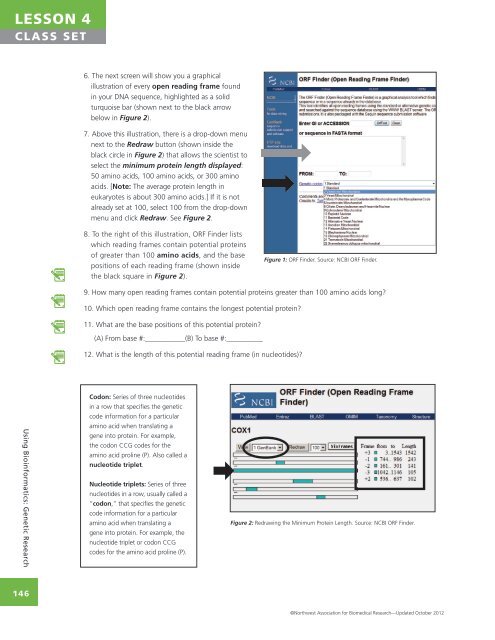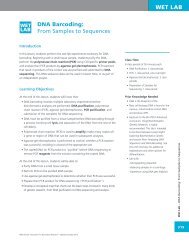LESSON 4 Using Bioinformatics to Analyze Protein Sequences
LESSON 4 Using Bioinformatics to Analyze Protein Sequences
LESSON 4 Using Bioinformatics to Analyze Protein Sequences
Create successful ePaper yourself
Turn your PDF publications into a flip-book with our unique Google optimized e-Paper software.
<strong>LESSON</strong> 4CLASS SET6. The next screen will show you a graphicalillustration of every open reading frame foundin your DNA sequence, highlighted as a solidturquoise bar (shown next <strong>to</strong> the black arrowbelow in Figure 2).7. Above this illustration, there is a drop-down menunext <strong>to</strong> the Redraw but<strong>to</strong>n (shown inside theblack circle in Figure 2) that allows the scientist <strong>to</strong>select the minimum protein length displayed:50 amino acids, 100 amino acids, or 300 aminoacids. [Note: The average protein length ineukaryotes is about 300 amino acids.] If it is notalready set at 100, select 100 from the drop-downmenu and click Redraw. See Figure 2.8. To the right of this illustration, ORF Finder listswhich reading frames contain potential proteinsof greater than 100 amino acids, and the basepositions of each reading frame (shown insidethe black square in Figure 2).Figure 1: ORF Finder. Source: NCBI ORF Finder.9. How many open reading frames contain potential proteins greater than 100 amino acids long?10. Which open reading frame contains the longest potential protein?11. What are the base positions of this potential protein?(A) From base #:___________(B) To base #:__________12. What is the length of this potential reading frame (in nucleotides)?<strong>Using</strong> <strong>Bioinformatics</strong>: Genetic ResearchCodon: Series of three nucleotidesin a row that specifies the geneticcode information for a particularamino acid when translating agene in<strong>to</strong> protein. For example,the codon CCG codes for theamino acid proline (P). Also called anucleotide triplet.Nucleotide triplets: Series of threenucleotides in a row, usually called a“codon,” that specifies the geneticcode information for a particularamino acid when translating agene in<strong>to</strong> protein. For example, thenucleotide triplet or codon CCGcodes for the amino acid proline (P).Figure 2: Redrawing the Minimum <strong>Protein</strong> Length. Source: NCBI ORF Finder.146©Northwest Association for Biomedical Research—Updated Oc<strong>to</strong>ber 2012
















